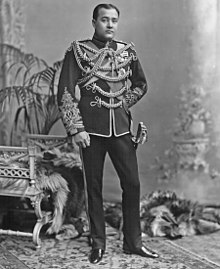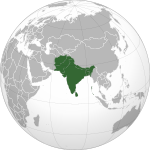The Koch dynasty (Pron: kɒʧ; 1515–1949) ruled parts of eastern Indian subcontinent in present-day Assam and Bengal. Established by Biswa Singha, the dynasty came to power in the erstwhile Kamata kingdom which had emerged from the decaying Kamarupa kingdom. The dynasty came to power by removing the Baro-Bhuyans, who had earlier removed the short-lived rule established by Alauddin Hussain Shah.
The dynasty forked for the first time into two major branches that controlled Koch Bihar and Koch Hajo. Koch Bihar became a vassal of the Mughals, whereas Koch Hajo came under Ahom control and was subsequently absorbed. Koch Bihar became a princely state during British rule and was absorbed after Indian independence. The third branch of this dynasty at Khaspur disappeared into the Kachari kingdom.
Etymology
The name Koch denotes a matrilineal ethnic group to which Biswa Singha’s mother belonged; and the king as well as most of the population of the kingdom (Koch Bihar) belonged to the Koch community.
History
Historical background
After the fall of the Pala dynasty of Kamarupa, the kingdom fractured into different domains in the 12th century. Sandhya, a ruler of Kamarupanagara (Guwahati) moved his capital further west to present-day North Bengal in the middle of the 13th century and the domain he ruled over came to be called Kamata kingdom. The buffer region, between the eastern kingdoms and Kamata was the domain of the Baro-Bhuyans chieftains. Alauddin Husain Shah of Gaur defeated Nilambar of Kamata in 1498, occupied the region and placed his son, Sayyid Danyal in charge. Within a few years, the Baro-Bhuyans, led by one Harup Narayan of the Brahmaputra valley defeated, captured and executed Daniyal, and the region lapsed into Bhuyan confederate rule.
The Koch dynasty in Kamata was one of several tribal formations that developed into statehoods around 15th century in northeast India—Ahom, Chutia, Dimasa, Tripura, Manipur, etc. An alliance was formed when a Mech chief, Hariya Mandal, married two sisters Hira and Jira, the daughters of Hajo, a Koch chief. Hariya Mandal’s domain was in Chikna Mountains situated between the Sankosh River and the Champabati River in Kokrajhar district of Undivided Goalpara district of Assam. Bisu, who was to later become Biswa Singha, was born to the Mech father and the Koch mother, Hariya and Hira respectively.


Consolidation of power
Biswa Singha sought the alliance of tribal (Koch, Garo and Mech) chiefs against the more powerful Baro-Bhuyans and began his campaign around 1509. Successively, he defeated the Bhuyans of Ouguri, Jhargaon, Karnapur, Phulaguri, Bijni and Pandunath (Pandu, in Guwahati). He was particularly stretched by the Bhuyan of Karnapur, and could defeat him only by a stratagem during Bihu. After subjugating the petty rulers, he announced himself the king of Kamata bounded on the east by Barnadi river and on the west by the Karatoya river in the year 1515. He moved his capital from Chikana to Kamatapur (also called Kantapur) which is just a few miles southeast of the present-day Cooch Behar town.
Sanskritisation
Later, Brahman pundits created a legend that lord Siva was the father of Biswa Singha to give legitimacy to his rule and conferred on him the status of the Kshatriya varna and the subsequent interaction with Brahmans led to the Hinduization of his tribesmen. The process of hinduisation was much slower in the lower strata of the society than in the royal family. Biswa Singha with this new found position claimed Rajbanshi kshatriya status though the lower class Koch took the name after the 18th century.
Zenith
Biswa Singha’s two sons, Naranarayan and Shukladhwaj (Chilarai), the king and the commander-in-chief of the army respectively, took the kingdom to its zenith. Nara Narayan made Raghudev, the son of Chilarai, the governor of Koch Hajo, the eastern portion of the country. After the death of Nara Narayan, Raghudev declared independence. The division of the Kamata kingdom into Koch Bihar and Koch Hajo was permanent.
Branches
Rulers of undivided Koch kingdom
- Biswa Singha (1515-1540)
- Nara Narayan (1540-1586)
Rulers of Koch Bihar

Maharaja Nripendra Narayan of Cooch Bihar
- Lakshmi Narayan
- Bir Narayan
- Pran Narayan
- Basudev Narayan
- Mahindra Narayan
- Roop Narayan
- Upendra Narayan
- Devendra Narayan
- Dhairjendra Narayan
- Rajendra Narayan
- Dharendra Narayan
- Harendra Narayan
- Shivendra Narayan
- Narendra Narayan
- Nripendra Narayan
- Rajendra Narayan II
- Jitendra Narayan (father of Gayatri Devi)
- Jagaddipendra Narayan
- Virajdendra Narayan
Rulers of Koch Hajo
- Raghudev (son of Chilarai, nephew of Nara Narayan)
- Parikshit Narayan
Rulers of Darrang
The Mughal Subah, in alliance with Lakshmi Narayan of Koch Bihar, attacked Parikshit Narayan of Koch Hajo in 1612. Koch Hajo, bounded by Sankosh River in the west and Barnadi river in the east, was occupied by the end of that year. Parikshit Narayan was sent to Delhi for an audience with the Mughal Emperor, but his brother Balinarayan escaped and took refuge in the Ahom kingdom. The region to the east of Barnadi and up to the Bharali river was under the control of some Baro-Bhuyan chieftains, but they were soon removed by the Mughals. In 1615 the Mughals, under Syed Hakim and Syed Aba Bakr, attacked the Ahoms but were repelled back to the Barnadi river. The Ahom king, Prataap Singha, then established Balinarayan as a vassal in the newly acquired region between Barnadi and Bharali rivers, and called it Darrang. Balinarayan’s descendants continued to rule the region as a tributary to the Ahom kingdom till it was annexed by the British in 1826.
- Balinarayan (brother of Parikshit Narayan)
- Mahendra Narayan
- Chandra Narayan
- Surya Narayan
Rulers of Beltola
| Outline of South Asian history |
|---|
 |
- Gaj Narayan Dev (brother of Parikshit Narayan, ruler of Koch Hajo, brother of Balinarayan, first Koch ruler of Darrang).
- Shivendra Narayan Dev (Son of Gaj Narayan)
- Gandharva Narayan Dev (Son of Shivendra Narayan)
- Uttam Narayan Dev (Son of Gandharva Narayan Dev)
- Dhwaja Narayan Dev (Son of Uttam Narayan Dev)
- Jay Narayan Dev (Son of Dhwaja Narayan Dev)
- Lambodar Narayan Dev (Son of Jay Narayan Dev)
- Lokpal Narayan Dev (Son of Lambodar Narayan Dev)
- Amrit Narayan Dev (Son of Lokpal Narayan Dev)
- Chandra Narayan Dev (Son of Lokpal Narayan Dev) (died 1910 CE)
- Rajendra Narayan Dev (Son of Chandra Narayan Dev) (died 1937 CE)
- Lakshmipriya Devi (wife of Rajendra Narayan Dev) (reign:1937-1947 CE died: 1991 CE)
Rulers of Bijni
The Bijni rulers reigned between the Sankosh and the Manas rivers, the region immediately to the east of Koch Bihar.
- Chandra Narayan (son of Parikshit Narayan)
- Joy Narayan
- Shiv Narayan
- Bijoy Narayan
- Mukunda Narayan
- Haridev Narayan
- Balit Narayan
- Indra Narayan
- Amrit Narayan
- Kumud Narayan
- Jogendra Narayan
- Bhairabendra Narayan
Rulers of Khaspur
The Barak valley was obtained by Chilarai in 1562 from the Twipra kingdom during his expedition when he subjugated most of the major rulers in Northeast India and established the Khaspur state with a garrison at Brahmapur, that eventually came to be called Khaspur (Brahmapur→Kochpur→Khaspur). The Koch rule began with the appointment of Kamal Narayan (step-brother of Chilarai and Naranarayan) as the Dewan a couple of years after the establishment of the garrison. Kamalnarayan established eighteen clans of Koch families that took hereditary roles in the state of Khaspur and who came to be known as Dheyans (after Dewan). The independent rule of the Khaspur rulers ended in 1745 when it merged with the Kachari kingdom.
The rulers of the Koch kingdom at Khaspur were:
- Kamal Narayan (Gohain Kamal, son of Biswa Singha, governor of Khaspur)
- Udita Narayan (declared independence of Khaspur in 1590)
- Vijay Narayana
- Dhir Narayana
- Mahendra Narayana
- Ranjit
- Nara Singha
- Bhim Singha (his only issue, daughter Kanchani, married a prince of Kachari kingdom, and Khaspur merged with the Kachari kingdom.)
